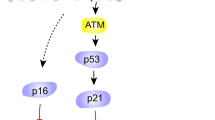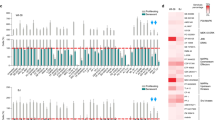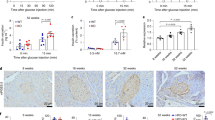Abstract
Cellular senescence is thought to contribute to age-associated deterioration of tissue physiology. The senescence effector p16Ink4a is expressed in pancreatic beta cells during aging and limits their proliferative potential; however, its effects on beta cell function are poorly characterized. We found that beta cell–specific activation of p16Ink4a in transgenic mice enhances glucose-stimulated insulin secretion (GSIS). In mice with diabetes, this leads to improved glucose homeostasis, providing an unexpected functional benefit. Expression of p16Ink4a in beta cells induces hallmarks of senescence—including cell enlargement, and greater glucose uptake and mitochondrial activity—which promote increased insulin secretion. GSIS increases during the normal aging of mice and is driven by elevated p16Ink4a activity. We found that islets from human adults contain p16Ink4a-expressing senescent beta cells and that senescence induced by p16Ink4a in a human beta cell line increases insulin secretion in a manner dependent, in part, on the activity of the mechanistic target of rapamycin (mTOR) and the peroxisome proliferator-activated receptor (PPAR)-γ proteins. Our findings reveal a novel role for p16Ink4a and cellular senescence in promoting insulin secretion by beta cells and in regulating normal functional tissue maturation with age.
This is a preview of subscription content, access via your institution
Access options
Subscribe to this journal
Receive 12 print issues and online access
$209.00 per year
only $17.42 per issue
Buy this article
- Purchase on Springer Link
- Instant access to full article PDF
Prices may be subject to local taxes which are calculated during checkout






Similar content being viewed by others
Accession codes
References
Muñoz-Espín, D. & Serrano, M. Cellular senescence: from physiology to pathology. Nat. Rev. Mol. Cell Biol. 15, 482–496 (2014).
van Deursen, J.M. The role of senescent cells in aging. Nature 509, 439–446 (2014).
Storer, M. et al. Senescence is a developmental mechanism that contributes to embryonic growth and patterning. Cell 155, 1119–1130 (2013).
Muñoz-Espín, D. et al. Programmed cell senescence during mammalian embryonic development. Cell 155, 1104–1118 (2013).
Kim, W.Y. & Sharpless, N.E. The regulation of INK4-ARF in cancer and aging. Cell 127, 265–275 (2006).
Nielsen, G.P. et al. Immunohistochemical survey of p16INK4A expression in normal human adult and infant tissues. Lab. Invest. 79, 1137–1143 (1999).
Krishnamurthy, J. et al. Ink4a-Arf expression is a biomarker of aging. J. Clin. Invest. 114, 1299–1307 (2004).
Burd, C.E. et al. Monitoring tumorigenesis and senescence in vivo with a p16INK4a-luciferase model. Cell 152, 340–351 (2013).
Krishnamurthy, J. et al. p16INK4a induces an age-dependent decline in islet regenerative potential. Nature 443, 453–457 (2006).
Janzen, V. et al. Stem cell aging modified by the cyclin-dependent kinase inhibitor p16INK4a. Nature 443, 421–426 (2006).
Molofsky, A.V. et al. Increasing p16INK4a expression decreases forebrain progenitors and neurogenesis during aging. Nature 443, 448–452 (2006).
Baker, D.J. et al. Clearance of p16Ink4a-positive senescent cells delays aging-associated disorders. Nature 479, 232–236 (2011).
Baker, D.J. et al. Naturally occurring p16Ink4a-positive cells shorten healthy lifespan. Nature 530, 184–189 (2015).
Salama, R., Sadaie, M., Hoare, M. & Narita, M. Cellular senescence and its effector programs. Genes Dev. 28, 99–114 (2014).
Dörr, J.R. et al. Synthetic-lethal metabolic targeting of cellular senescence in cancer therapy. Nature 501, 421–425 (2013).
Kaplon, J. et al. A key role for mitochondrial gatekeeper pyruvate dehydrogenase in oncogene-induced senescence. Nature 498, 109–112 (2013).
Takebayashi, S. et al. Retinoblastoma protein promotes oxidative phosphorylation through upregulation of glycolytic genes in oncogene-induced senescent cells. Aging Cell 14, 689–697 (2015).
Gumbiner, B. et al. Effects of aging on insulin secretion. Diabetes 38, 1549–1556 (1989).
Iozzo, P. et al. Independent influence of age on basal insulin secretion in nondiabetic humans. J. Clin. Endocrinol. Metab. 84, 863–868 (1999).
Basu, R. et al. Mechanisms of the age-associated deterioration in glucose tolerance: contribution of alterations in insulin secretion, action and clearance. Diabetes 52, 1738–1748 (2003).
Kushner, J.A. The role of aging upon beta cell turnover. J. Clin. Invest. 123, 990–995 (2013).
Chen, H. et al. Polycomb protein Ezh2 regulates pancreatic beta cell Ink4a-Arf expression and regeneration in diabetes mellitus. Genes Dev. 23, 975–985 (2009).
Bao, X.Y., Xie, C. & Yang, M.S. Association between type 2 diabetes and CDKN2A/B: a meta-analysis study. Mol. Biol. Rep. 39, 1609–1616 (2012).
Annicotte, J.S. et al. The CDK4-pRB-E2F1 pathway controls insulin secretion. Nat. Cell Biol. 11, 1017–1023 (2009).
González-Navarro, H. et al. Increased dosage of Ink4-Arf protects against glucose intolerance and insulin resistance associated with aging. Aging Cell 12, 102–111 (2013).
Moreno-Asso, A., Castaño, C., Grilli, A., Novials, A. & Servitja, J.M. Glucose regulation of a cell cycle gene module is selectively lost in mouse pancreatic islets during aging. Diabetologia 56, 1761–1772 (2013).
Abella, A. et al. Cdk4 promotes adipogenesis through PPAR-γ activation. Cell Metab. 2, 239–249 (2005).
Lee, Y. et al. Cyclin D1–Cdk4 controls glucose metabolism independently of cell cycle progression. Nature 510, 547–551 (2014).
Ruvinsky, I. et al. Ribosomal protein S6 phosphorylation is a determinant of cell size and glucose homeostasis. Genes Dev. 19, 2199–2211 (2005).
Chicas, A. et al. Dissecting the unique role of the retinoblastoma tumor suppressor during cellular senescence. Cancer Cell 17, 376–387 (2010).
Brady, C.A. et al. Distinct p53 transcriptional programs dictate acute DNA-damage responses and tumor suppression. Cell 145, 571–583 (2011).
Acosta, J.C. et al. A complex secretory program orchestrated by the inflammasome controls paracrine senescence. Nat. Cell Biol. 15, 978–990 (2013).
Lujambio, A. et al. Non–cell autonomous tumor suppression by p53. Cell 153, 449–460 (2013).
Stolovich-Rain, M. et al. Weaning triggers a maturation step of pancreatic beta cells. Dev. Cell 32, 535–545 (2015).
van Arensbergen, J. et al. Derepression of Polycomb targets during pancreatic organogenesis allows insulin-producing beta cells to adopt a neural gene activity program. Genome Res. 20, 722–732 (2010).
Holland, A.M., Hale, M.A., Kagami, H., Hammer, R.E. & MacDonald, R.J. Experimental control of pancreatic development and maintenance. Proc. Natl. Acad. Sci. USA 99, 12236–12241 (2002).
Gauthier, B.R. et al. PDX1 deficiency causes mitochondrial dysfunction and defective insulin secretion through TFAM suppression. Cell Metab. 10, 110–118 (2009).
Wiederkehr, A. & Wollheim, C.B. Mitochondrial signals drive insulin secretion in the pancreatic beta cell. Mol. Cell. Endocrinol. 353, 128–137 (2012).
Rane, S.G. et al. Loss of Cdk4 expression causes insulin-deficient diabetes and Cdk4 activation results in beta islet cell hyperplasia. Nat. Genet. 22, 44–52 (1999).
Wicksteed, B. et al. Conditional gene targeting in mouse pancreatic beta cells: analysis of ectopic Cre transgene expression in the brain. Diabetes 59, 3090–3098 (2010).
Scharfmann, R. et al. Development of a conditionally immortalized human pancreatic beta cell line. J. Clin. Invest. 124, 2087–2098 (2014).
Morita, M. et al. mTORC1 controls mitochondrial activity and biogenesis through 4E-BP–dependent translational regulation. Cell Metab. 18, 698–711 (2013).
Koyanagi, M. et al. Ablation of TSC2 enhances insulin secretion by increasing the number of mitochondria through activation of mTORC1. PLoS One 6, e23238 (2011).
Fingar, D.C., Salama, S., Tsou, C., Harlow, E. & Blenis, J. Mammalian cell size is controlled by mTOR and its downstream targets S6K1 and 4EBP1-eIF4E. Genes Dev. 16, 1472–1487 (2002).
Dor, Y., Brown, J., Martinez, O.I. & Melton, D.A. Adult pancreatic beta cells are formed by self-duplication rather than by stem cell differentiation. Nature 429, 41–46 (2004).
Ohn, J.H. et al. 10-year trajectory of beta cell function and insulin sensitivity in the development of type 2 diabetes: a community-based prospective cohort study. Lancet Diabetes Endocrinol. 4, 27–34 (2016).
Narita, M. et al. Rb-mediated heterochromatin formation and silencing of E2F target genes during cellular senescence. Cell 113, 703–716 (2003).
Bandyopadhyay, D. et al. Dynamic assembly of chromatin complexes during cellular senescence: implications for the growth arrest of human melanocytic nevi. Aging Cell 6, 577–591 (2007).
Chandra, T. et al. Global reorganization of the nuclear landscape in senescent cells. Cell Reports 10, 471–483 (2015).
Giordano, E. et al. Beta cell size influences glucose-stimulated insulin secretion. Am. J. Physiol. 265, C358–C364 (1993).
Correia-Melo, C. & Passos, J.F. Mitochondria: are they causal players in cellular senescence? Biochim. Biophys. Acta 1847, 1373–1379 (2015).
Nicolay, B.N. et al. Proteomic analysis of pRb loss highlights a signature of decreased mitochondrial oxidative phosphorylation. Genes Dev. 29, 1875–1889 (2015).
Avrahami, D. et al. Aging-dependent demethylation of regulatory elements correlates with chromatin state and improved beta cell function. Cell Metab. 22, 619–632 (2015).
Ahmadian, M. et al. PPAR-γ signaling and metabolism: the good, the bad and the future. Nat. Med. 19, 557–566 (2013).
Chang, J. et al. Clearance of senescent cells by ABT263 rejuvenates aged hematopoietic stem cells in mice. Nat. Med. 22, 78–83 (2016).
Nardella, C., Clohessy, J.G., Alimonti, A. & Pandolfi, P.P. Pro-senescence therapy for cancer treatment. Nat. Rev. Cancer 11, 503–511 (2011).
Turner, N.C. et al. Palbociclib in hormone receptor–positive advanced breast cancer. N. Engl. J. Med. 373, 209–219 (2015).
Tokarsky-Amiel, R. et al. Dynamics of senescent cell formation and retention revealed by p14ARF induction in the epidermis. Cancer Res. 73, 2829–2839 (2013).
Milo-Landesman, D. et al. Correction of hyperglycemia in diabetic mice transplanted with reversibly immortalized pancreatic beta cells controlled by the Tet-on regulatory system. Cell Transplant. 10, 645–650 (2001).
Sharpless, N.E. et al. Loss of p16Ink4a with retention of p19Arf predisposes mice to tumorigenesis. Nature 413, 86–91 (2001).
Nir, T., Melton, D.A. & Dor, Y. Recovery from diabetes in mice by beta cell regeneration. J. Clin. Invest. 117, 2553–2561 (2007).
O'Gorman, D. et al. Comparison of human islet isolation outcomes using a new mammalian tissue-free enzyme versus collagenase NB-1. Transplantation 90, 255–259 (2010).
Dai, C. et al. Islet-enriched gene expression and glucose-induced insulin secretion in human and mouse islets. Diabetologia 55, 707–718 (2012).
Walsh, R.M. et al. Improved quality of life following total pancreatectomy and auto–islet transplantation for chronic pancreatitis. J. Gastrointest. Surg. 16, 1469–1477 (2012).
Debacq-Chainiaux, F., Erusalimsky, J.D., Campisi, J. & Toussaint, O. Protocols to detect senescence-associated β-galactosidase (SA–β-gal) activity, a biomarker of senescent cells in culture and in vivo. Nat. Protoc. 4, 1798–1806 (2009).
Trapnell, C. et al. Differential analysis of gene regulation at transcript resolution with RNA-seq. Nat. Biotechnol. 31, 46–53 (2013).
Acknowledgements
We thank M. Barbacid for CDK4lsl-R24C mice, L. Philipson for MIP-CreER mice, R. Scharfmann for the EndoC-βH2 cells; S. Efrat for the pTRIPΔU3-CMV-nlsCre vector and C. Wright for the Pdx1-specific antibody. We thank N.E. Kidess-Bassir for histological preparation and T. Szoke for experimental assistance. This research was supported by a postdoctoral fellowship from the Juvenile Diabetes Research Foundation (A.H.) and by grants from Israel Science Foundation (grant no. 1009/13; I.B.-P.), the Jacob and Lena Joels Memorial Foundation Senior Lectureship for Excellence in the Life and Medical Sciences (I.B.-P.), Diabetes Onderzoek Nederland (Y.D. and I.B.-P.), the Alex U. Soyka program (Y.D. and I.B.-P.), the Juvenile Diabetes Research Foundation (Y.D. and A.C.P.), the US National Institutes of Health (NIH) Beta Cell Biology Consortium (Y.D.), the Leona M. and Harry B. Helmsley Charitable Trust (Y.D.), the Israeli Centers Of Research Excellence Program of the Planning and Budgeting Committee and the Israel Science Foundation (grant no. 41.11; Y.D.), the United States Agency for International Development's American Schools and Hospitals Abroad Program (Y.D. and I.B.-P.), the Network for Pancreatic Organ Donors with Diabetes (nPOD) (Y.D.), the US Department of Veterans Affairs (A.C.P.), the National Institute of Diabetes and Digestive and Kidney Diseases–NIH (grant no. DK089572 (A.C.P.), DK72473 (A.C.P.) and DK104211 (A.C.P.)), and the Vanderbilt Diabetes Research and Training Center (grant no. DK20593; A.C.P.). Organ procurement organizations partnering with nPOD are listed at http://www.jdrfnpod.org/our-partners.php.
Author information
Authors and Affiliations
Contributions
A.H., I.B.-P. and Y.D. designed experiments, analyzed data and wrote the manuscript; A.H. performed experiments; A.K., N.A., Y.G., E.H., S.A., A.S., R.C., Y.F., D.S., A.Z., S.T.-B., B.G., C.D. and A.C.P. did experiments and contributed experimental data; R.Z.G. and Y.N. performed bioinformatic analyses; A.M.J.S. contributed human islet samples; and M.A.M. assisted in generation of the tet-p16 mice.
Corresponding authors
Ethics declarations
Competing interests
A.H., A.K., Y.D. and I.B.-P. are inventors of intellectual property related to this work.
Supplementary information
Supplementary Text and Figures
Supplementary Figures 1–8 and Supplementary Tables 2–3 (PDF 3286 kb)
Supplementary Table 1
Gene expression changes in p16-expressing beta cells (XLSX 45 kb)
Rights and permissions
About this article
Cite this article
Helman, A., Klochendler, A., Azazmeh, N. et al. p16Ink4a-induced senescence of pancreatic beta cells enhances insulin secretion. Nat Med 22, 412–420 (2016). https://doi.org/10.1038/nm.4054
Received:
Accepted:
Published:
Issue Date:
DOI: https://doi.org/10.1038/nm.4054
This article is cited by
-
Genetically prolonged beige fat in male mice confers long-lasting metabolic health
Nature Communications (2023)
-
The meaning of adaptation in aging: insights from cellular senescence, epigenetic clocks and stem cell alterations
Nature Aging (2023)
-
Multiparity increases the risk of diabetes by impairing the proliferative capacity of pancreatic β cells
Experimental & Molecular Medicine (2023)
-
Mapping cellular senescence networks in human diabetic foot ulcers
GeroScience (2023)
-
Loss of fragile WWOX gene leads to senescence escape and genome instability
Cellular and Molecular Life Sciences (2023)



